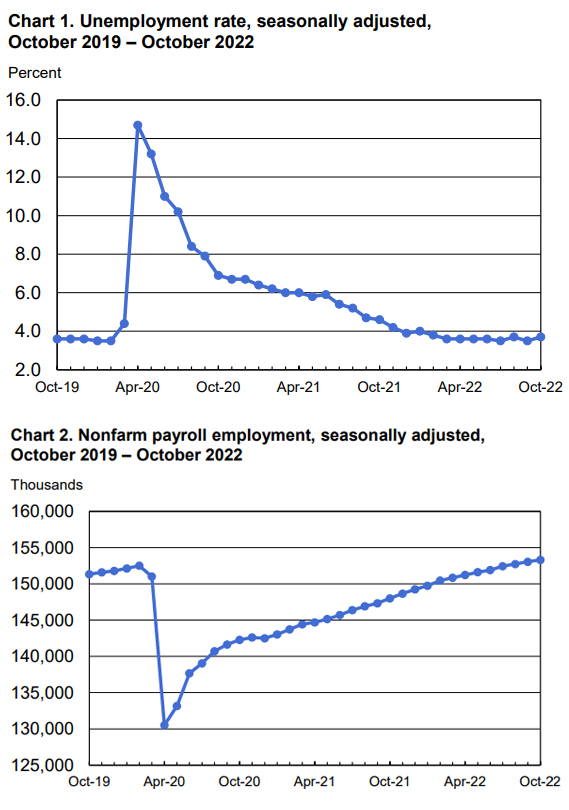 Today’s employment report in October’s Employment Situation Summary from The U.S. Bureau of Labor Statistics (BLS) provided a snapshot of the labor market at a time of aggressive Federal Reserve interest-rate increases and a cooling of the overall economy, which grew at a 2.6% annual rate in the third quarter.
Today’s employment report in October’s Employment Situation Summary from The U.S. Bureau of Labor Statistics (BLS) provided a snapshot of the labor market at a time of aggressive Federal Reserve interest-rate increases and a cooling of the overall economy, which grew at a 2.6% annual rate in the third quarter.
Slightly above analysts’ expectations the BLS reported a gain of 261,000 non-farm jobs while unemployment rose to 3.7 percent.
Among the civilian workforce with a bachelor’s degree or higher (the primary target of the MRINetwork’s recruitment efforts), unemployment remained at historic lows at 1.9 percent.
“Job growth continued into October despite Federal Reserve efforts to slow the economy and reduce inflation through interest-rate hikes. As the lead up to the mid-term election reaches its final few days, I’ll defer to the political experts to comment on the wisdom any governmental or financial strategy to tame inflation and grow the economy.
However, I can comment on what I see on the employment front line for executive, technical, professional, and managerial talent. To put it succinctly, hiring and retaining top talent in virtually every industry remains the most important consideration and priority at every level of our best clients’ organizations,” said Bert Miller, President and CEO of MRI — a global Network of over 250 executive recruiting firms.
“We urge our clients to consistently evaluate and selectively invest in transformative talent through most business cycles. A focus on attributes is essential. Factors like cognitive intelligence, integrity, endurance, abstract thinking, and teamwork are key. Then, evaluate skills and education. Don’t zero-in purely on formal institutions or degrees but rather their experiences, not their experience, to understand whether an individual is capable of continuous learning.”
At Wednesday’s Fed meeting, Chairman Jerome Powell said that to tame inflation, the central bank would likely have to raise rates high enough to weaken the job market. That could mean hiring will slow in the coming months.
Providing an analogy to the Fed’s efforts, Robert Dent, senior U.S. economist at Nomura commented, “The labor market’s going from 100 miles per hour to 85 while the Fed’s looking for 40, and we’re still not very close to that.” However, the continued rate of hiring in today’s BLS report shows an underlying demand for skilled workers leading Augustine Faucher, chief economist at PNC Financial Services Group to ask, “The question is, do we see it [the labor market] continue to overheat, or does it slow more quickly to a more sustainable pace?”
Total nonfarm payroll employment increased by 261,000 in October. Monthly job growth has averaged 407,000 thus far in 2022, compared with 562,000 per month in 2021.
Job gains rose modestly across most segments.
In October, employment in healthcare rose by 53,000. Professional and technical services added 43,000 jobs in October. Employment continued to trend up in management and technical consulting services (+7,000), architectural and engineering services (+7,000), and scientific research and development services (+5,000).
Employment in leisure and hospitality continued to trend up in October (+35,000), with accommodation adding 20,000 jobs. Employment in food services and drinking places changed little over the month (+6,000). Leisure and hospitality has added an average of 78,000 jobs per month thus far this year, less than half of the average gain of 196,000 jobs per month in 2021.
Manufacturing added 32,000 jobs in October, mostly in durable goods industries (+23,000). Wholesale trade added 15,000 jobs in October.
Employment in transportation and warehousing changed little in October (+8,000). Within the industry, job growth occurred in truck transportation (+13,000), couriers and messengers (+7,000), and air transportation (+4,000). These gains were partially offset by warehousing and storage declines of (-20,000).
In October, financial activities employment was little changed (+3,000).
Employment was also little changed versus the prior month in other major industries, including mining, construction, retail trade, information, other services, and government.
“Despite economic headwinds, demand for top talent remains strong and good hiring fundamentals remain essential. Strive to learn as much as possible about candidate experiences to understand the lessons, outcomes, and results the individual has acquired and achieved. It is essential to understand a candidate’s “why” — what drives them, how they operate, and how hard they are willing to sacrifice to achieve their goals and to contribute to the client’s mission,” noted Miller.

 Today’s employment report in October’s Employment Situation Summary from The U.S. Bureau of Labor Statistics (BLS) provided a snapshot of the labor market at a time of aggressive Federal Reserve interest-rate increases and a cooling of the overall economy, which grew at a 2.6% annual rate in the third quarter.
Today’s employment report in October’s Employment Situation Summary from The U.S. Bureau of Labor Statistics (BLS) provided a snapshot of the labor market at a time of aggressive Federal Reserve interest-rate increases and a cooling of the overall economy, which grew at a 2.6% annual rate in the third quarter.